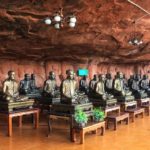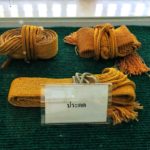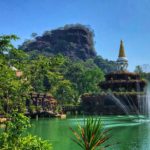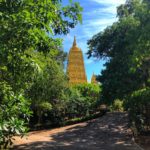The Isaan Monks of Thailand’s Forest Tradition
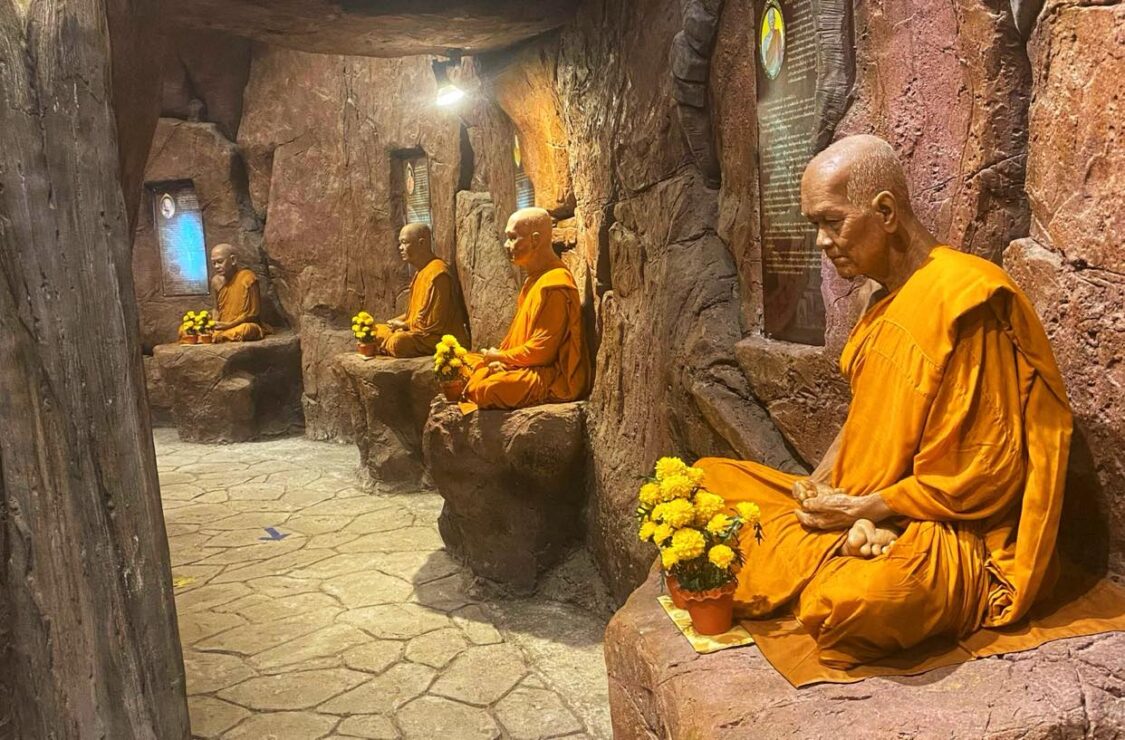
Sakon Nakhon is considered by many to be the spiritual mecca of Northeast Thailand (Isaan). This is evidenced by the cave exhibition at the Phu Phan Museum, which features life-like sculptures of eight of the most revered forest monks, all of whom had deep spiritual ties to Sakon Nakhon province. The most influential member of the Thai forest monks is Ajarn Man, the co-founder of the Thai Forest Tradition of Theravada Buddhism. He sits at the front of the cave, with the other Isaan monks sitting in a semi-circle behind him. Here is a brief profile of all 8 monks featured in the museum exhibition.
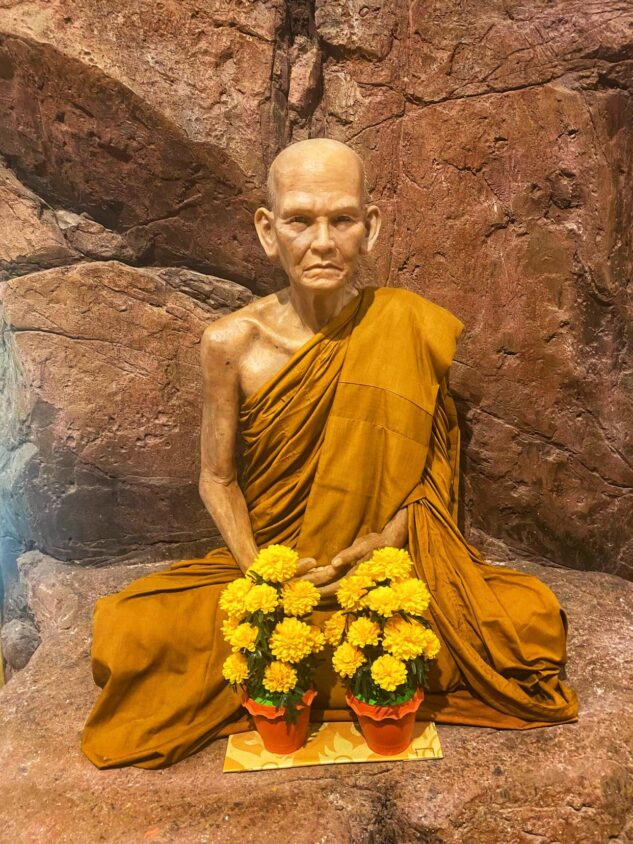
Phra Ajarn Man Phurithatto (พระอาจารย์มั่น ภูริทัตโต), the great master of the Vipassana meditation technique, and co-founder of Thailand’s Forest Tradition, was born in 1870 in the Khong Chiam District of Ubon Ratchathani Province (Northeast Thailand).
He was ordained as a novice monk at 15, and became fully ordained 8 years later at Wat Sri Ubon Rattanaram (วัดศรีอุบลรัตนาราม) in Ubon, after which he was given the nickname “Phurithatto,” meaning the “one who distributes wisdom”.
Ajarn Man (also spelled Ajahn Mun) wandered the forests of Northeast Thailand, Laos, and Burma with his teacher Phra Ajarn Sao Kantasilo (พระอาจารย์เสาร์ กันตสีโล), the other co-founder of Thailand’s Forest Tradition. For many years, he practiced asceticism in forests, mountain peaks, caves, cemeteries, abandoned houses, and on the banks of the Mekong River.
He was heavily influenced by the Dharma sermons of Phra Upali Kunupamachan (พระอุบาลีคุณูปมาจารย์ ), founder of the Ubon Wittayakhom School (โรงเรียนอุบลวิทยาคม) at Wat Supattanaram Worawihan in Ubon Ratchathani.
After spending several years in the central region of Thailand (including Khao Yai, Nakhon Nayok, and Lopburi), he returned to Northeast Thailand (Isaan) to teach his disciples, many of whom became prominent monks throughout Thailand.
Ajarn Man’s love for Sakon Nakhon was obvious in that he chose to spend his final 5 years at the Sakon Nakhon temple Wat Pa Phurithatta Thirawat (วัดป่าภูริทัตตถิราวาส), which now has a great gold Chedi built in his honor. Shortly before his death, he moved to Wat Pa Suttawat (วัดป่าสุทธาวาส) in the Meuang District of Sakon Nakhon, before passing away peacefully in 1949.
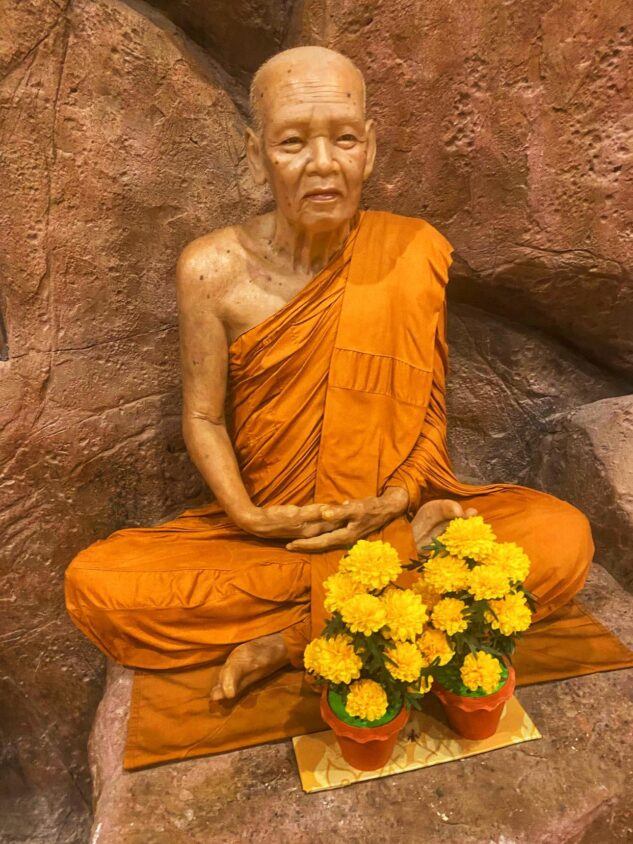
Phra Ajarn Thate Desaransi (พระอาจารย์เทสก์ เทสรังสี) is also known as Luang Pu Thet Thetrangsi, the latter name being closer to the correct Thai pronunciation. He was born in 1902 in the Baan Peur District of Udon Thani, and became ordained as a Buddhist monk in 1923. That same year he met Ajarn Man and became one of his early disciples.
Ajarn Thate was considered a meditation master. He traveled abroad to teach meditation and promote its practice. He thus not only had many Thai followers, but Western disciples, as well. He spent years at Wat Hin Mak Peng (วัดหินหมากเป้ง) on the Mekong River in Nong Khai province (Northeast Thailand).
After Ajarn Man’s death in 1949, Ajarn Thate was considered the head of the Forest Tradition until his death in 1994 (after which Ajarn Maha Bua became the leader).
Like his former teacher, Luang Pu Thet spent his final years in Sakon Nakhon. He resided at the hilltop temple Wat Tham Kham, which now has a majestic pagoda which holds his relics and honors his life, including photos of King Bhumibol Adulyadej The Great and Queen Sirikit visiting with the revered Isaan monk.
Upon his death at the age of 92, Thailand’s King donated a solid gold casket for the funeral and personally lit the cremation fire.
Ajarn Thate was known for his patience and gratitude, encouraging others to recognize that the world is our mind, and that what lies outside is not worth holding onto, for no one can take it with them upon their death.
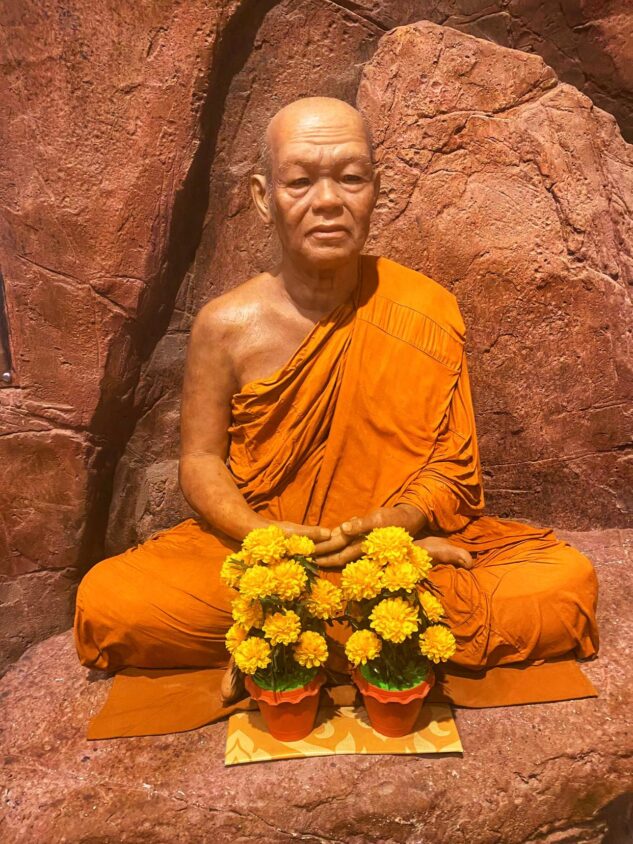
Phra Ajarn Fan Acharo (พระอาจารย์ฝั้น อาจาโร) was born in the Phanna Nikhom District of Sakon Nakhon in 1899, and ordained as a novice monk in 1919. He was a member of Sakon Nakhon’s famous Phu Thai tribe, which emigrated from Laos during the 19th century. He’s referred to by locals as “The Angel of Isaan” (เทพเจ้าแห่งอีสาน).
Ajarn Fan (also spelled Ajahn Fun) was recognized for being smart and quick-witted — an Isaan monk who welcomed everyone equally, with no regard to whether one was rich or poor, a senior or junior, a government official or farmer.
He had a very close relationship with HM King Bhumibol, who tried to visit with his revered friend every time he was in Northeast Thailand.
Ajarn Fan met Phra Ajarn Man in 1920, and on hearing his teachings of the Dharma, immediately offered to become his disciple. After years of education and practice in meditation, he become ordained as a full monk in 1925 — six years after his ordination as a Naga or novice monk.
Before passing away peacefully in 1977, Ajarn Fan had developed two Buddhist temples in Sakon Nakhon: the hilltop temple of Wat Tham Kham (วัดถ้ำขาม), and the forest temple Wat Pa Udom Somphon (วัดป่าอุดมสมพร) in his home district of Phanna Nikhom, the latter of which has a museum honoring the life of “The Angel of Issan” and houses his relics.
One of Ajarn Fan’s well-known sayings is: “If you want to be beautiful, keep the precepts. If you want to be rich, give alms. If you want to have wisdom to pray.”
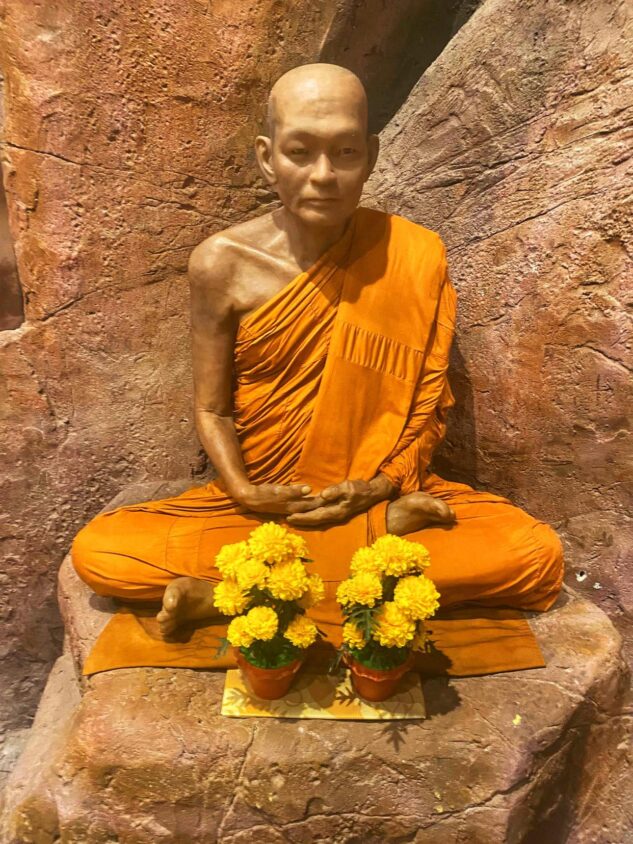
Phra Ajarn Wan Uttamo (พระอาจารย์วัน อุตตโม) was born in 1922 and ordained in 1936. He is the most recognized Isaan monk to have come from the Song Dao District of Sakon Nakhon province, where he built the famous mountain temple Wat Tham Apai Damrongtham (วดถ้ำอภัยดำรงธรรม), also known as Wat Tham Phuang.
Ajarn Wan followed the Forest Tradition of Phra Ajarn Sao Kantasilo (พระอาจารย์เสาร์ กันตสีโล) and Phra Ajarn Man. He served Ajarn Man during the final year of the Master’s life at Wat Pa Phurithatta Thirawat and Wat Pa Suttawat.
Ajarn Wan was known as Thailand’s “bulletproof monk,” having survived a hail of soldier gunfire during the 1970s after he and his entourage of monks were mistaken for communist rebels. He died tragically in a plane crash in 1980 at the age of 58.
The revered Song Dao monk was known for a keen understanding the power of words. He thus never complained of being tired, hungry, or thirst, etc. — because he said that by doing so, it would make matters worse.
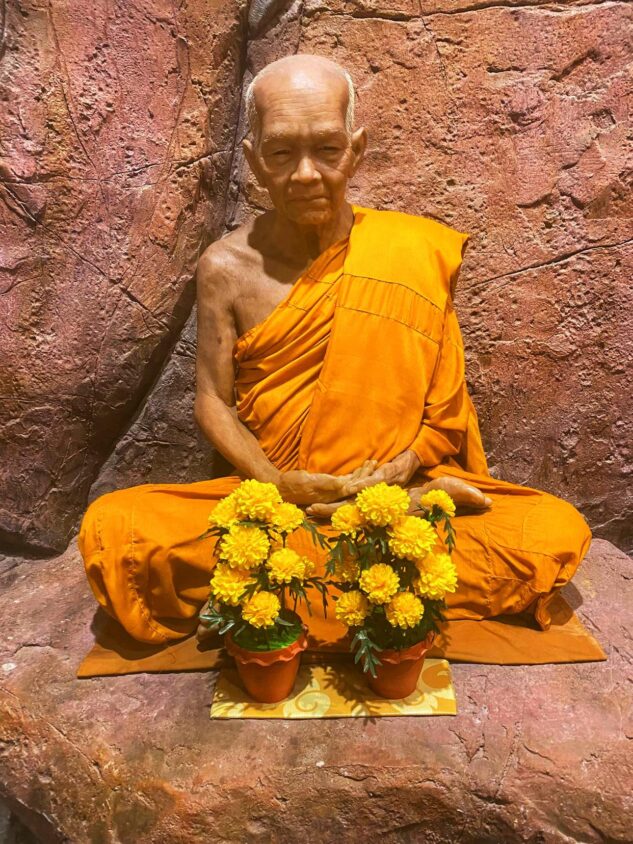
Phra Ajarn Maha Bua Yansampanno (พระอาจารย์มหาบัว ญาณสัมปันโน) is one of the most famous Thai monks from Isaan. He was born in 1913 in Udon Thani, which shares its southwestern border with Sakon Nakhon. He was ordained in 1934 and given the nickname “Yannasampanno” (ญาณสัมปันโน), which means “one who is fully equipped with insight.”
He modeled his Buddhist practices after Phra Ajarn Man, and became a “Master” in his own right, with many disciples who went on to become teachers of Buddhism and meditation. From 1994 until his death in 2011, he was considered the “Ajarn Yai” or head monk of Thailand’s Forest Tradition.
Ajarn Maha Bua was widely recognized for his charity work, his eloquent sermons on the Dharma, and his efforts to help Thailand’s economy during the Asian financial crisis of 1997 by depositing large amounts of gold into the government’s treasury.
Ajarn Maha Bua said that he achieved full enlightenment after the death of Ajarn Man in 1949. In deep grief, he fled to the Sakon Nakhon woods and undertook intense meditation at Wat Doi Dhamma Chedi (วัดดอยธรรมเจดีย์), a forest temple located in Amphur Khok Si Suphan. The enlightenment took place during his 16th Buddhist Lent, on the 14th night of the waning moon, in the 5th lunar month (May 15th, 1950) at 10:00 p.m.
Ajarn Maha Bua taught that if one lived according to the principles of faith, perseverance, mindfulness, concentration, and wisdom, then no matter whatever happens or wherever you go, you’ll never suffer loss and collapse.
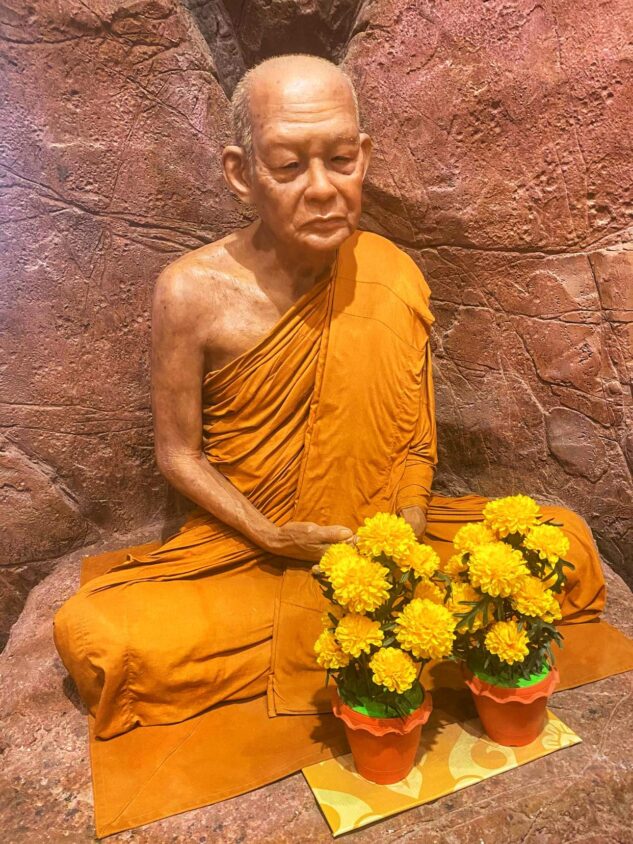
Phra Ajarn Louis Chantasaro (พระอาจารย์หลุย จันทสาโร) was born in 1901 in the Mueang District of Loei province (Northeast Thailand). He practiced Christianity for 5 years in his youth, during which time is uncle gave him the nickname “St. Louis”. He later converted to Buddhism and became ordained as a full monk in 1923.
He learned from both Phra Ajarn Man and Phra Ajarn Sao Kantasilo, following the latter in meditation pilgrimages through the forest; at the base of large trees; in valleys, mountains, and streams; and in caves, graveyards, and fields of grass.
Ajarn Louis frequently praised the benefits of meditating in the forest, stating that in mountains and large forests, the mind is awake with an awareness of every gesture; thus it reaches the right path more quickly, without hindrances disturbing it.
Ajarn Louis was known for his great humility, forsaking any thoughts of ambition (which often can occur even among Buddhist monks). He also emphasized the cleansing of the body (physically, emotionally, and spiritually), so as to remove all hindrances that come in forms such as lust, anger, and covetousness.
During his life, he walked the Phu Phan Mountain forests of Sakon Nakhon, and spent several Buddhist Lents in the Isaan province, in particular at Wat Tham Chao Phu Kha (วัดถ้ำเจ้าภูข้า), a forest cave temple in the Phanna Nikhom District.
He passed away peacefully in 1989 at the age of 88. At the behest of HM King Bhumibol, a pagoda museum honoring his life was built at Wat Pa Suttawat in Sakon Nakhon, which also is the location of the Ajarn Man museum.
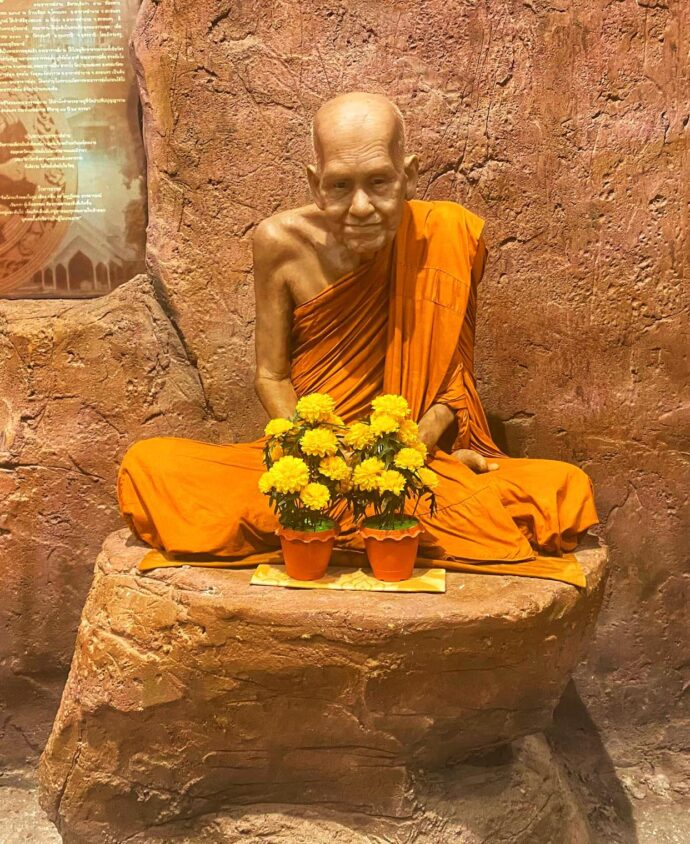
Phra Ajarn Phan Panya Patipo (พระอาจารย์ผ่าน ปัญญาปทีโป) is an Isaan forest monk who was born in Tambon Phon Phaeng, Sakon Nakhon in 1922. Ordained in 1942, he’s the most revered Buddhist monk to have emerged from the Akat Amnuai district of Sakon Nakhon province. He studied directly under Ajarn Man Phurithatto, as well as other Thai forest monks like Ajarn Fun Acharo.
He was known for never being bored or lazy, and viewed perseverance as the stronghold of one’s life. He taught that the nature of reality was like breathing. And that the person who realizes this truth should never be underestimated.
He spent his final years at Wat Pa Prathip Bunyaram (วัดป่าปทีปปุญญาราม) in Amphur Akat Amnuai, passing away peacefully in 2011, at the age of 89.
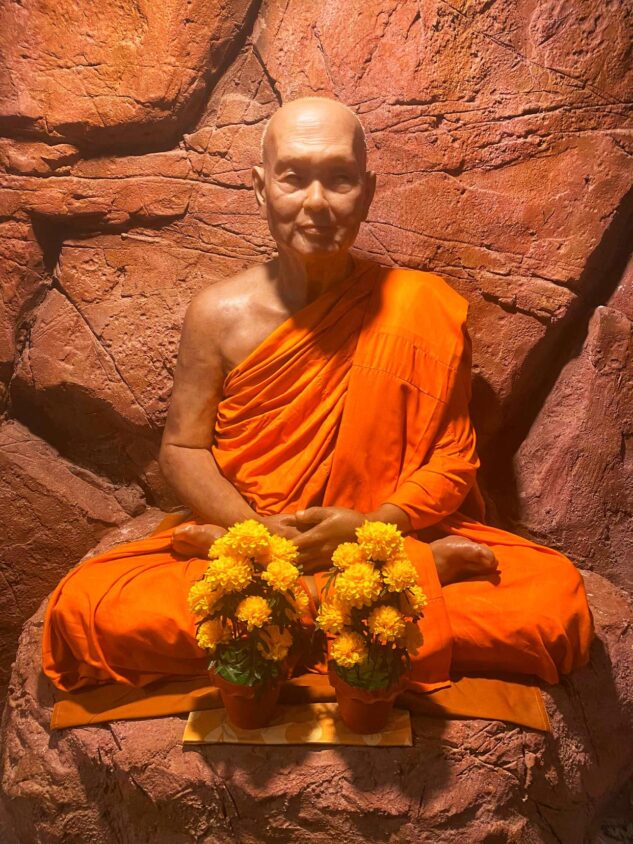
Phra Ajarn Sim Putthajaro (พระอาจารย์สิม พุทธาจาโร) was born in 1909 in the Sawang sub-district of Amphur Phanna Nikhom, Sakon Nakhon. As a novice monk, he studied under Phra Ajarn Man in Nakhon Phanom, which is Sakon Nakhon’s neighboring province to the east. Ajarn Man prophesied his spiritual development with the words: “You are a lotus flower. When the buds are in bloom, they are more fragrant than the others.”
Ajarn Sim was fully ordained in 1929 at Wat Srichan (วัดศรีจันทร์) in Khon Kaen. He went on many forest pilgrimages, before finally arriving in Chiang Mai, where he began building the temple Wat Santitham (วัดสันติธรรม) in 1949. Today, it is one of the most sacred temples in Chiang Mai.
Ajarn Sim was a forest monk who emphasized the importance of practice, so that one’s duties can be performed to perfection. He was known for having a firm heart and an unshakable faith in all aspects of the Dharma — fully understanding the truth that we are always teaching others via our thoughts, words, and actions (i.e. the person who we are). Thus we must always strive to be our best, and be ready to accept death at any moment.
He passed away peacefully in 1992, at the age of 83.
- Affirmations in Buddhism & Thailand - June 7, 2025
- Speak Thai Naturally Without the Gymnastics - April 20, 2025
- The Best Learn Thai Podcast and YouTube Channel - April 10, 2025

